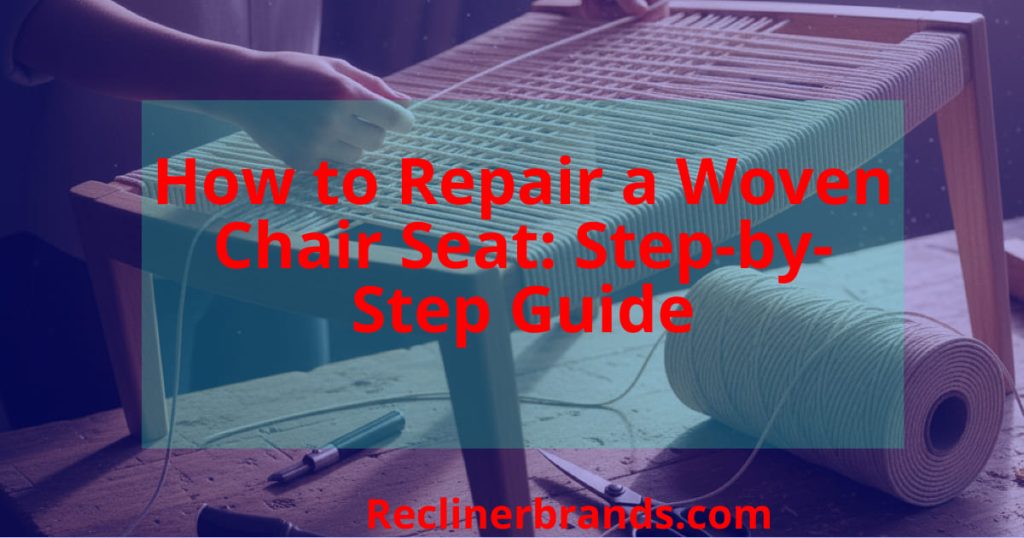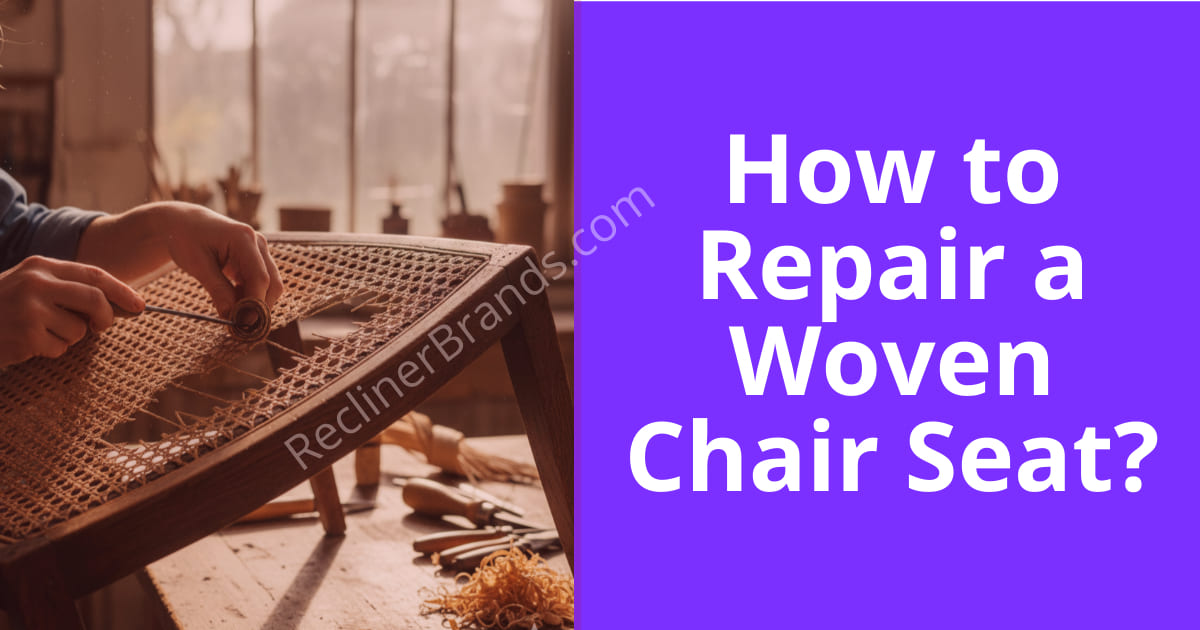Woven chair seats are timeless pieces that bring charm and functionality to any space. However, wear and tear over time can leave your chair looking less than its best. Instead of discarding it, learning how to repair a woven chair seat can be a cost-effective and rewarding way to restore its beauty and function. This guide will walk you through the process step by step, ensuring your chair seat regains its original appeal.
In addition, we’ll discuss related topics like “What is a woven chair seat?” and “How to replace a woven seat with Danish cord”, offering you insights into different styles and techniques.
What Is a Woven Chair Seat?
A woven chair seat is a seating surface created by weaving natural or synthetic materials across the frame of a chair. This traditional method combines craftsmanship with functionality, resulting in a supportive and durable seat that adds aesthetic charm to any furniture piece. Woven chair seats are versatile and can be found in a variety of chair styles, from rustic farmhouse designs to iconic Danish modern furniture.
Characteristics of a Woven Chair Seat
- Durable Construction: The interwoven pattern evenly distributes weight, making it strong and supportive.
- Timeless Appeal: The natural textures and intricate designs of woven materials enhance the visual appeal of the chair.
- Eco-Friendly Options: Many woven materials, such as cane and rush, are sustainable and biodegradable.
- Customization Potential: A woven chair seat can be tailored to match the chair’s design, whether through choice of material or weaving pattern.

Common Materials Used in Woven Chair Seats
Understanding the material of your woven chair seat is essential when learning how to repair a woven chair seat. Each material offers unique properties, requiring specific tools and techniques for maintenance or replacement.
1. Cane
- What It Is: Cane is derived from the outer bark of the rattan palm, sliced into thin, pliable strips.
- Uses: Often woven into intricate patterns, cane is a popular choice for lightweight, elegant chair seats.
- Benefits: Durable, flexible, and visually appealing, cane is perfect for classic or vintage furniture.
- Care Tips: Keep cane furniture away from high humidity to prevent sagging and mildew.
2. Rush
- What It Is: Rush is made from twisted natural fibers like cattails, bulrush, or man-made materials like paper cord.
- Uses: Commonly found in rustic or country-style chairs, rush offers a sturdy, textured finish.
- Benefits: Rush seats provide a charming, handmade appearance and excellent durability.
- Care Tips: Avoid exposure to moisture, as rush fibers can weaken over time.
3. Danish Cord
- What It Is: A tightly wound, durable paper cord often used in mid-century modern Scandinavian furniture.
- Uses: Ideal for minimalist designs, Danish cord is frequently featured in iconic chairs like the Wishbone Chair.
- Benefits: Provides a sleek, modern aesthetic with exceptional durability and comfort.
- Care Tips: Protect from spills and stains by using a fabric protector or light sealant.
4. Seagrass
- What It Is: A natural material harvested from aquatic plants, offering a rustic and textured look.
- Uses: Commonly used in coastal or farmhouse-style chairs, seagrass adds an organic touch to furniture.
- Benefits: Seagrass is sturdy, biodegradable, and visually unique.
- Care Tips: Regular cleaning and protection from excessive moisture will prolong its lifespan.
5. Synthetic Options
- What They Are: Synthetic materials like vinyl or resin are designed to mimic natural fibers while offering enhanced durability.
- Uses: Often used in outdoor furniture due to their weather-resistant properties.
- Benefits: Resistant to water, UV rays, and wear, synthetic options are ideal for patio chairs or high-use furniture.
- Care Tips: Clean with mild soap and water to maintain their appearance.
Choosing the right material for your woven chair seat is critical, as it impacts the chair’s longevity and maintenance requirements. When repairing or replacing a seat, always match the material to the original design for consistency.

Tools and Materials Needed to Repair a Woven Chair Seat
Successfully learning how to repair a woven chair seat begins with assembling the proper tools and materials. The right equipment ensures a smooth repair process and a professional-looking result.
Essential Tools
1. Scissors or Utility Knife
- Purpose: Used to cut away old or damaged material and trim replacement strands.
- Keep blades sharp for clean, precise cuts, especially when working with tough materials like Danish cord or synthetic fibers.
2. Measuring Tape
- Purpose: Helps measure the frame and replacement materials accurately, ensuring a snug fit.
- Always double-check measurements to avoid cutting material too short.
3. Awl or Small Screwdriver
- Purpose: Used to pry out stubborn pieces of old material or open existing holes in the chair frame.
- Work gently to avoid damaging the wood or frame finish.
4. Needle-Nose Pliers
- Purpose: Ideal for pulling out old staples, tacks, or weaving material lodged in the frame.
- Choose pliers with a non-slip grip for better control during detailed work.
5. Clamp or Frame Holder (Optional)
- Purpose: Keeps the chair frame steady while weaving, ensuring even tension in the new material.
Necessary Materials
1. Replacement Weaving Material
- Purpose: The core component for the repair. Match the material (cane, rush, Danish cord, etc.) to the original seat.
- If unsure, take a small sample of the old material to a supplier for guidance.
2. Glue or Wood Adhesive
- Purpose: Secures ends of the material and reinforces joints during repairs.
- Use a clear-drying adhesive for a seamless look.
3. Tacks or Nails
- Purpose: Fasten the weaving material to the chair frame securely.
- Choose tacks that match the frame’s finish to maintain a polished appearance.
4. Finish or Sealant
- Purpose: Protects the repaired seat from moisture, stains, and wear.
- Select a non-glossy finish to retain the natural look of woven materials.
Additional Tips for Preparation
- Organize Your Workspace: Use a flat, stable surface with plenty of light to prevent mistakes.
- Test Your Tools: Ensure your scissors, pliers, and awl are in good condition before starting.
- Wear Gloves: Protect your hands when working with tough or sharp materials like cane or rush.
With the right tools and materials, repairing your woven chair seat becomes a manageable and rewarding project, preserving the charm and functionality of your furniture.

How to Repair a Woven Chair Seat: Step-by-Step Guide
Repairing a woven chair seat requires precision, patience, and the right materials. This step-by-step guide ensures your chair is not only restored but looks as good as new. If you’re wondering how to repair a woven chair seat, these detailed instructions will guide you through the process, whether you’re fixing a minor issue or replacing the entire seat.
Step 1: Assess the Damage
The first step in learning how to repair a woven chair seat is evaluating the current condition of the seat. Understanding the extent of the damage will help you decide whether to repair individual strands or replace the entire seat.
- Inspect for Minor Damage:
- Check for loose or broken strands that can be repaired without removing the entire weave.
- Assess whether the damaged strands can be glued, tightened, or replaced individually.
- Evaluate for Full Replacement:
- Look for sagging, tearing, or significant wear in multiple areas.
- If the seat feels unstable or has gaps that compromise its structure, a full replacement is likely necessary.
- Document the Existing Weave:
- Take clear photos of the current weaving pattern from multiple angles.
- Note any unique designs or details to replicate the original look during the repair.
Use a flashlight to inspect hard-to-see areas and ensure you don’t miss subtle damage.
Step 2: Remove the Damaged Material
Removing old, damaged material is essential for a clean, successful repair. Whether you’re repairing minor sections or replacing the entire weave, follow these steps:
- Cut Away the Material:
- Use sharp scissors or a utility knife to cut through broken or loose strands.
- Start from one side of the seat and work systematically to remove all damaged pieces.
- Handle Stubborn Pieces:
- For material stuck in grooves or wrapped tightly around the frame, use pliers or an awl to carefully pry it loose.
- Avoid using excessive force to prevent damaging the chair frame.
- Clean and Prepare the Frame:
- Sand down any rough edges or splinters on the chair frame to prevent the new weaving material from snagging.
- Wipe the frame with a damp cloth to remove dust, debris, or old adhesive residue.
If the frame is damaged or loose, reinforce it with wood glue or small nails before starting the weaving process.
Step 3: Prepare the Replacement Material
Choosing and preparing the right material is crucial when learning how to repair a woven chair seat. Proper preparation ensures the material is flexible, durable, and ready for weaving.
- Natural Materials (Cane or Rush):
- Soak the cane or rush in warm water for 30–60 minutes to make it pliable.
- Remove from water and pat dry to avoid excess moisture.
- Inspect the material for imperfections, such as splits or knots, and trim as needed.
- Synthetic Materials:
- Stretch synthetic cords to remove any kinks or bends before weaving.
- Cut the material into manageable lengths, leaving extra at the ends for securing.
- Measure and Cut:
- Use the frame dimensions to cut the material to the required length.
- Always add an additional 6–8 inches for securing knots or tacking.
If you’re replacing the seat with a different material, such as Danish cord, ensure it complements the chair’s style and size.
Step 4: Start Weaving the Chair Seat
Weaving is the most critical part of learning how to repair a woven chair seat. This step requires precision and patience to ensure a sturdy, attractive result.
- Anchor the Material:
- Secure one end of the material to the frame using tacks, nails, or glue.
- Start at the center or one corner, depending on the original weaving pattern.
- Horizontal Weaving:
- Stretch the material tightly across the seat frame from side to side.
- Secure each strand firmly on the opposite side of the frame to maintain tension.
- Leave equal spacing between strands to ensure a consistent weave.
- Vertical Weaving:
- Begin weaving vertically by going over and under the horizontal strands.
- Alternate the pattern with each row to create a grid-like structure.
- Pull the material taut to avoid sagging and secure it firmly at each turn.
- Edge Binding:
- Finish the edges by tucking the ends under the frame or securing them with glue.
- Trim excess material to give the seat a clean, polished look.
Use clamps or ask for assistance to hold the frame steady while weaving, ensuring even tension across the seat.
Step 5: Finish the Seat
The final step in how to repair a woven chair seat is finishing your work to ensure durability and a professional appearance.
- Seal Natural Materials:
- Apply a light coat of varnish, shellac, or wood finish to protect natural materials like cane or rush from fraying or moisture damage.
- Allow the finish to dry completely before using the chair.
- Trim and Tidy:
- Use sharp scissors to trim any loose strands or excess material.
- Inspect the seat for uneven spacing or loose ends and adjust as needed.
- Test the Seat:
- Gently press or sit on the seat to test its stability and comfort.
- Make final adjustments to the tension if necessary.
If you’re new to weaving, start with a simple pattern and progress to more intricate designs as you gain confidence.
By following these expanded steps, you’ll gain a deeper understanding of how to repair a woven chair seat and achieve a professional-quality result. This process not only restores your chair’s functionality but also preserves its timeless charm.

How to Replace a Woven Seat with Danish Cord
Knowing how to replace a woven seat with Danish cord is a fantastic way to give your chair a fresh, modern look while maintaining durability and functionality. Danish cord is a popular material often used in Scandinavian and mid-century furniture, known for its clean lines and timeless aesthetic. If you’re wondering how to repair a woven chair seat with Danish cord, this guide will walk you through the process step by step.
Why Choose Danish Cord for Replacement?
Danish cord is a tightly twisted paper cord that provides a sturdy and comfortable seating surface. It’s an excellent choice for chairs with damaged woven seats for several reasons:
- Durability: Danish cord is strong and long-lasting, making it ideal for high-use furniture.
- Modern Aesthetics: Its minimalist look complements mid-century modern designs like the iconic Wishbone Chair.
- Sustainability: Made from natural materials, Danish cord is eco-friendly and biodegradable.
- Ease of Maintenance: It’s easy to clean and resists sagging when woven tightly.
Replacing a worn woven seat with Danish cord gives your chair a contemporary upgrade while preserving its original charm.
Materials Needed for Danish Cord Replacement
To successfully replace a woven seat with Danish cord, gather the following materials:
- Danish Cord
- Purchase cord specifically designed for chair weaving.
- Measure your seat dimensions to estimate the amount needed (typically 200–300 feet for a standard chair).
- Upholstery Nails or Tacks
- Use small nails or tacks to anchor the cord to the chair frame.
- Choose nails that are rust-resistant if the chair will be used outdoors.
- Glue or Adhesive (Optional)
- For added security, you can use wood glue or a similar adhesive to keep the cord in place.
- Scissors or Utility Knife
- For cutting the cord cleanly.
- Ruler or Measuring Tape
- Ensures precise spacing during weaving.
Consider adding a cushion or padding underneath the cord for extra comfort if the chair will be used for extended periods.
Step-by-Step Instructions to Replace a Woven Seat with Danish Cord
Replacing your woven seat with Danish cord involves a methodical approach to ensure a neat and professional-looking result.
1. Prepare the Frame
Before starting the weaving process, prepare the chair frame for the new material:
- Remove Old Material:
- Cut and remove the existing woven seat, using pliers or an awl to take out any remaining material.
- Clear away all staples, nails, or tacks from the previous weave.
- Sand and Clean the Frame:
- Smooth the edges of the frame with fine-grit sandpaper to prevent the cord from snagging or fraying during weaving.
- Wipe down the frame with a damp cloth to remove dust or debris.
Apply a coat of wood finish or sealant to the frame for added protection and a polished look before starting the weave.
2. Start Weaving the Horizontal Wraps
The horizontal wraps form the base layer of your new Danish cord seat:
- Anchor the Cord:
- Secure one end of the Danish cord to the back rail of the chair frame using an upholstery nail or tack.
- Leave a small tail of cord (approximately 1–2 inches) and tuck it underneath the wraps during weaving.
- Wrap the Cord:
- Begin wrapping the cord tightly and evenly across the frame, moving from the back rail to the front rail.
- Maintain consistent spacing between each strand (about 1/8 to 1/4 inch, depending on your desired look).
- Secure the cord to the front rail with another tack or nail once you reach the end.
- Check Tension:
- Ensure the cord is pulled taut with each wrap to create a firm, supportive surface.
Use a ruler or guide to maintain even spacing between the wraps for a uniform appearance.
3. Add Vertical Weaving
The vertical weaving creates the interlocking pattern that gives Danish cord seats their distinctive look:
- Anchor the Cord:
- Attach the cord to one side rail of the chair frame with a tack or nail.
- Begin Weaving:
- Weave the cord over and under the horizontal strands, alternating with each pass.
- Pull the cord tightly after each strand to ensure the weave stays firm.
- Secure Each Turn:
- At the end of each vertical pass, secure the cord to the opposite side rail with a tack or adhesive before doubling back.
- Finish the Weave:
- Continue weaving until the seat is completely covered.
- Secure the final end of the cord with a tack, nail, or glue.
Use a weaving shuttle or flat tool to help guide the cord through the horizontal wraps, especially in tight spaces.
4. Finish and Trim
To complete the project:
- Secure the Final End:
- Tuck the loose end of the cord neatly under the weave and secure it with glue or a nail.
- Trim Excess Cord:
- Use scissors or a utility knife to cut off any remaining cord, ensuring a clean finish.
- Inspect the Weave:
- Check for consistent spacing, tightness, and any loose strands. Make adjustments as needed.
- Apply a Finish (Optional):
- For natural cord, consider applying a protective sealant to enhance durability and resist stains.
Test the seat by gently pressing down to ensure it feels secure and evenly woven before use.
Challenges and Tips for Replacing Woven Seats with Danish Cord
- Maintain Tension: Keeping the cord tight during weaving is essential for a firm seat. Use clamps to help maintain tension if needed.
- Take Breaks: Danish cord weaving is labor-intensive and requires precision. Take breaks to avoid fatigue and ensure accuracy.
- Practice Makes Perfect: If you’re new to weaving, practice on a small frame or scrap wood before working on the actual chair.
Why Replace a Woven Seat with Danish Cord?
Switching to Danish cord offers several advantages:
- Durability: Danish cord is less prone to sagging and wear than some natural materials like rush or cane.
- Modern Aesthetic: It gives your chair a sleek, updated look that complements contemporary and mid-century interiors.
- Eco-Friendly: Made from natural paper fiber, Danish cord is a sustainable and biodegradable option.
Whether you’re learning how to repair a woven chair seat or giving it a modern makeover with Danish cord, this replacement process ensures your chair remains stylish, functional, and comfortable for years to come.
FAQs (Frequently Asked Questions): How to repair a woven chair seat
What is a woven chair seat?
Answer: A woven chair seat is made by weaving natural or synthetic materials like cane, rush, or Danish cord across a chair frame to create a supportive surface. These seats are durable, comfortable, and often found in traditional and mid-century designs.
How do I know if I need to repair or replace my woven chair seat?
Answer: Minor damage, such as a few broken strands, can be repaired. However, if the seat is sagging, torn, or heavily worn, a full replacement is the best option.
How do I replace a woven seat with Danish cord?
Answer: To replace a woven seat with Danish cord, remove the old material, anchor the cord to the frame, and weave it tightly in horizontal and vertical patterns. Secure the ends with tacks or glue for a polished finish.
Can I use synthetic materials for woven chair seat repairs?
Answer: Yes, synthetic materials like vinyl cord or resin are durable, weather-resistant alternatives to natural materials and are ideal for outdoor furniture.
How do I maintain a woven chair seat after repair?
Answer: To maintain a woven chair seat, clean it regularly with a damp cloth and avoid placing it in direct sunlight or areas with high humidity. For natural materials, apply a sealant to protect against wear and moisture.
Conclusion
Learning how to repair a woven chair seat not only restores your furniture’s functionality but also preserves its aesthetic value. Whether you’re fixing minor damage, replacing the seat with Danish cord, or exploring new weaving patterns, this DIY project is both rewarding and practical.
By knowing what a woven chair seat is and following the step-by-step guide, you can confidently repair your chair and extend its lifespan. Embrace this opportunity to add a personal touch to your furniture while keeping traditional craftsmanship alive.




